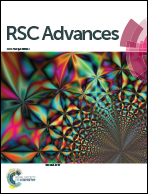Monodisperse TiO2 mesoporous spheres with core–shell structure: candidate photoanode materials for enhanced efficiency dye sensitized solar cells†
Abstract
We report a facile synthesis of monodisperse TiO2 spheres with controllable internal structure and surface areas of 17.9–348.8 m2 g−1, which were assembled from porous nanoparticles with average diameters of about 7–16 nm. The internal structures of the as-prepared spheres could be controlled by adjusting the hydrothermal reaction time, while keeping other parameters constant. Finally, novel mesoporous spheres with core–shell structure were assembled. This unique TiO2 core–shell structure with mesopores has filled a gap in the literature on TiO2 structures. In order to demonstrate their potential application, dye-sensitized solar cells (DSSCs) with a double layered photoanode structure were fabricated using either the as-obtained TiO2 spheres with different internal structures or nanometer-sized TiO2 crystals. The results showed that the DSSCs using the mesoporous spheres with core–shell structure as a top-layer exhibited much higher energy conversion efficiency (9.11%) and short-circuit photocurrent density (18.55 mA cm−2), indicating a 38% increase in the energy conversion efficiency compared to those using as-prepared TiO2 nanocrystals (6.62%). This significant improvement in photoelectric properties was mainly due to the excellent light scattering and dye absorption abilities of the novel structures. The results offer useful guidance in designing photoanode materials.


 Please wait while we load your content...
Please wait while we load your content...